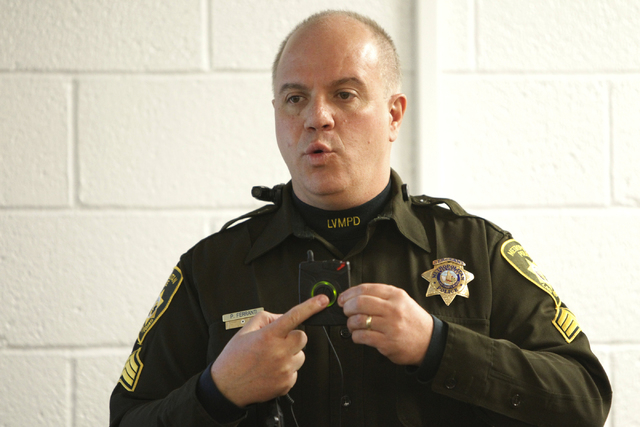400 officers involved in Metro body camera study — VIDEO
Las Vegas police soon will take a closer look at how officers and the public react to body cameras.
Four hundred Metro officers volunteered to go under the microscope as part of a yearlong study that will analyze the effects of officers wearing the 3-inch devices.
The study, a joint venture between the National Institute of Justice and the CNA Corporation, a nonprofit research and analysis organization, split the officers into two groups: Half will wear body cameras, while the other 200 will act as the control group.
Over the next year, the two groups will be compared with each another, measuring the number of incidents involving mainly use of force, police misconduct and stop-and-frisks to determine the effectiveness of the cameras, according to Dr. Bill Sousa, the director of the University of Nevada, Las Vegas’ Center for Crime and Justice Policy. UNLV is acting as the coordinator for the study, and Sousa will be heading the CNA Corporation portion of the study.
“If there are any significant differences between the camera group officers and the control group officers, then at that point we can reasonably attribute those differences to the presence of the camera,” Sousa said.
Video from the cameras, which can be worn on the collar or on a pair of glasses, provide a point-of-view that seems like it is right out of a first-person-shooter video game.
The department showcased their new Taser Axon Flex body cameras Wednesday to Las Vegas media.
In a staged performance for reporters and photographers, an officer made a mock stop on a man who appeared to be breaking into a car. From a bystander perspective, it looked like officer Nicole Hemsey fired blanks at the man, played by fellow officer Chad Lyman, as he knelt and surrendered.
But Hemsey’s body camera video, replayed minutes later, told a different story.
When the suspect lifted his hands, video showed, Hemsey could see a gun in Lyman’s waistband. As he knelt to the ground, he pulled out the gun, and Hemsey fired.
The cameras are connected via a cord to a device worn either on the officer’s shirt or belt. They constantly record in 30- second loops, with no audio, filming over video unless the officer wants to make a longer recording. The officer must manually activate the camera by pressing a button on the device twice.
When manually activated, the camera also records audio with video continuously until the officer presses the button to turn it off. Batteries should last the length of an officer’s shift, typically 10 hours at Metro.
Officers will be expected to activate their cameras every time they leave their patrol vehicles on a call or when they suspect a crime is being committed, said Lt. Dan Zehnder, who is overseeing the program.
At the end of their shift, officers simply place the cameras into a docking station. The docking station automatically uploads whatever the officers recorded and sends them to a database in online cloud storage run by the camera’s manufacturer.
With all the extra equipment, training and possible scrutiny, officers were hesitant to jump at the chance to wear one, making it tough to get the body camera program off the ground.
“Cops tend to be technophobes,” Zehnder said. “It takes them a while to get used to technology.”
Deputy Chief Tom Roberts, who oversees Metro’s patrol division, said it took some hard selling to get the 400 officers on board for the study. But officers seem to have “gone over the hump,” and most are on board with the new technology, Roberts said.
Eventually, every Metro patrol officer and several others who interact with the public will have to wear the cameras, which already have been tested by police in New York, Los Angeles and Phoenix.
“Within a short period of time, we believe that this will become second nature,” Zehnder said.
The U.S. Justice Department says evidence shows police officers and the people they encounter behave better when cameras are present.
But the cameras do not come without concerns and controversy.
Critics worry about the privacy of certain victims, such as juveniles and sexual assault victims, and how the department will protect their identities.
“There are serious privacy concerns with the technology,” said Jay Stanley, privacy expert for the national American Civil Liberties Union. “Police will be recording not just high-profile shootings and crime. They enter people’s homes. We don’t want to see that moment ending up on YouTube.”
And while the ACLU typically stands against police surveillance, they see the benefit of body cameras.
“This is a system that has a lot of potential to serve as an oversight mechanism for police,” Stanley said, but added that if used unethically, it could become a serious concern.
“We don’t want this technology to become another tool for mass surveillance,” he said.
Zehnder said that the department understands the concerns and that Metro policy gives officers discretion to turn the camera off when they don’t think it’s needed, such as when interviewing a sexual assault victim.
“We’re not going to put these folks’ pictures on TV,” Zehnder said.
While the cameras seem like an ideal problem solver, they aren’t perfect.
“The camera doesn’t always catch everything,” Zehnder said.
“People should not have an expectation that consistently you’re going to get steady video on a very dynamic situation.”
The cameras are held in place by a magnet. It won’t be uncommon for the camera to move, fall off or even have the wire ripped out if an officer has to get physical, said Sgt. Peter Ferranti, who works with Zehnder in the body camera detail.
Metro hopes the estimated $1.6 million program will result in a more transparent department the community can trust. Outgoing Clark County Sheriff Doug Gillespie endorsed a body camera program in 2012, amid calls for investigations into the frequency of officer-involved shootings.
“We want the community to see how we operate, how we do business, on a daily basis,” Zehnder said.
Contact reporter Colton Lochhead at clochhead@reviewjournal.com or 702-383-4638.








































